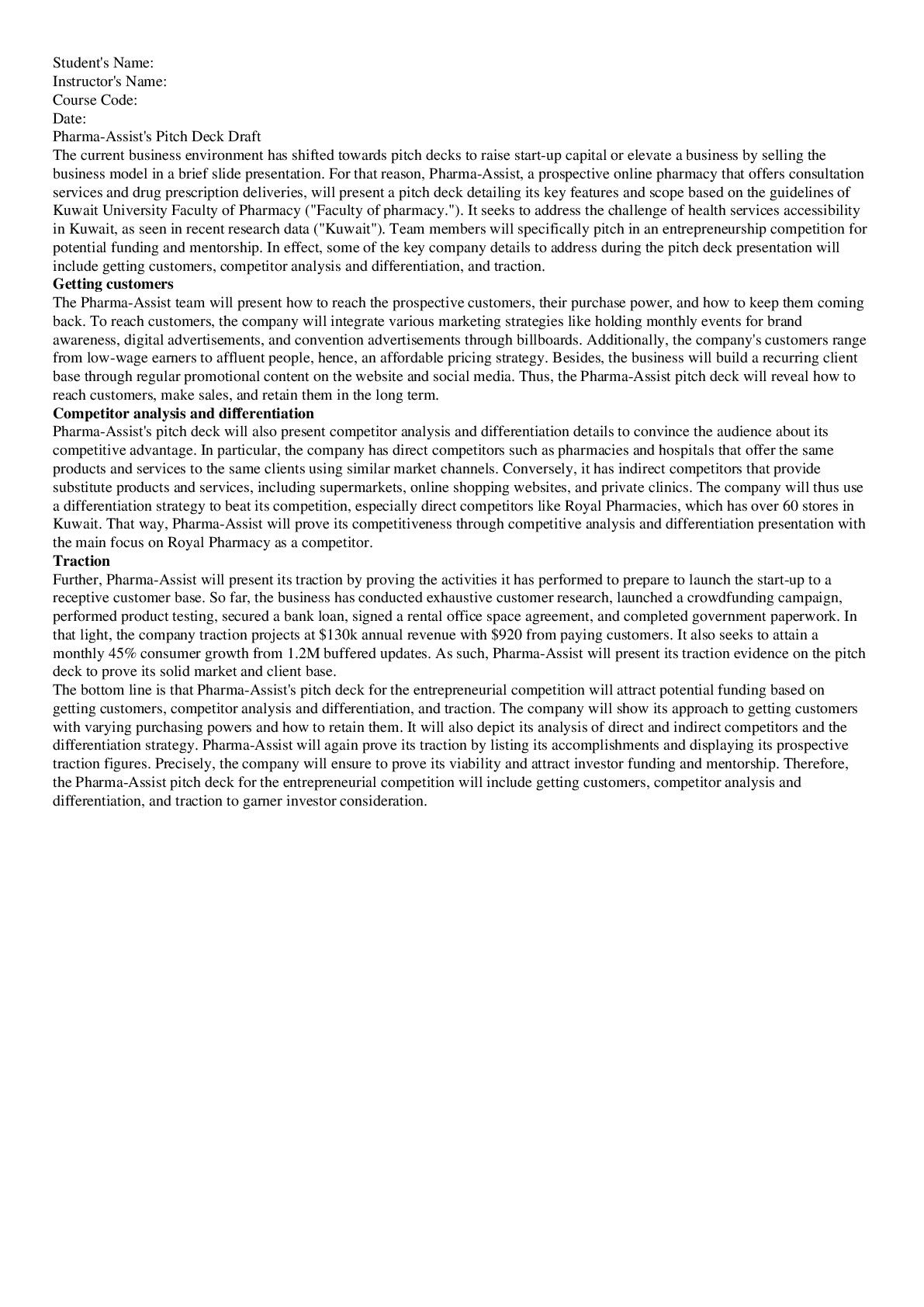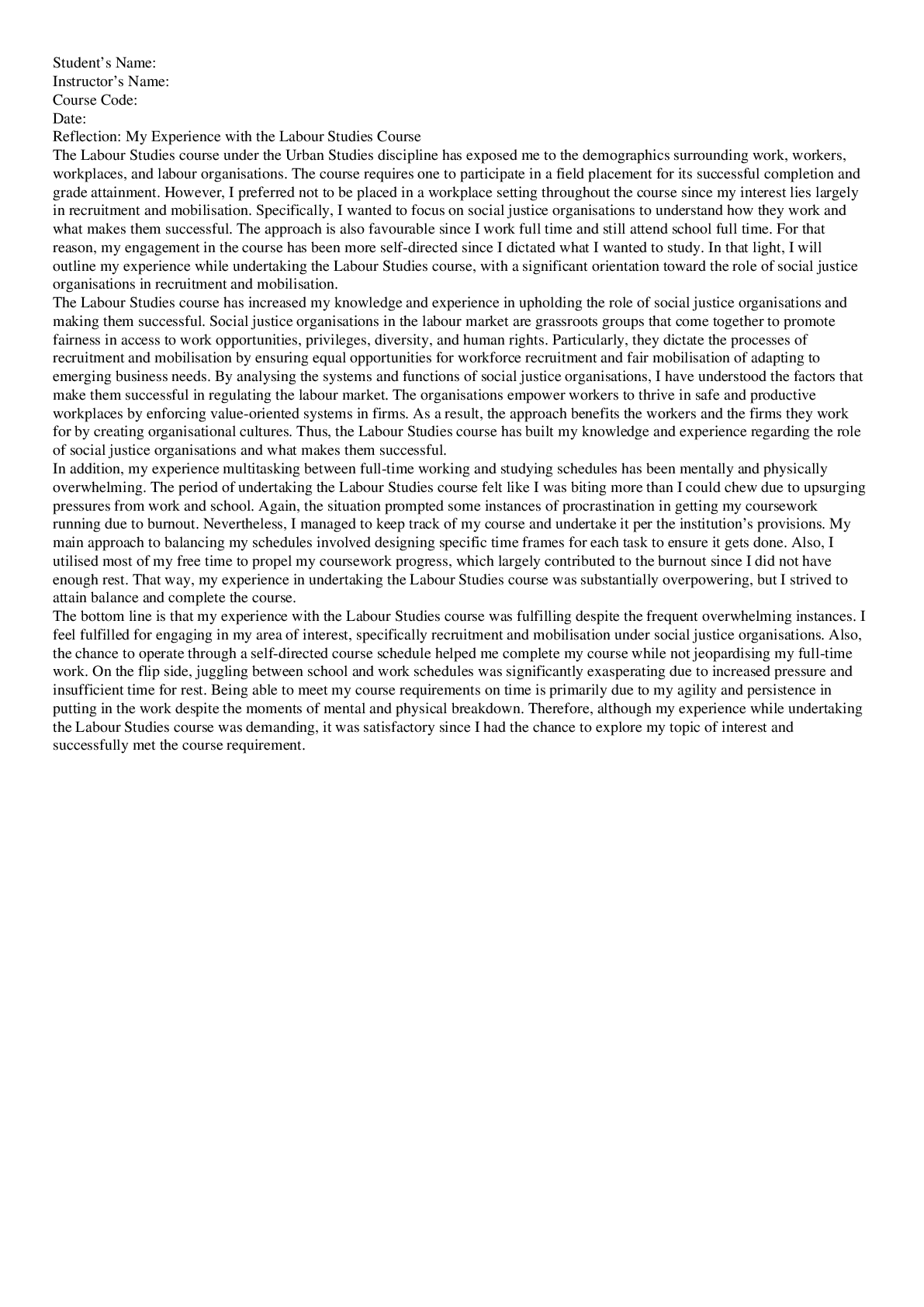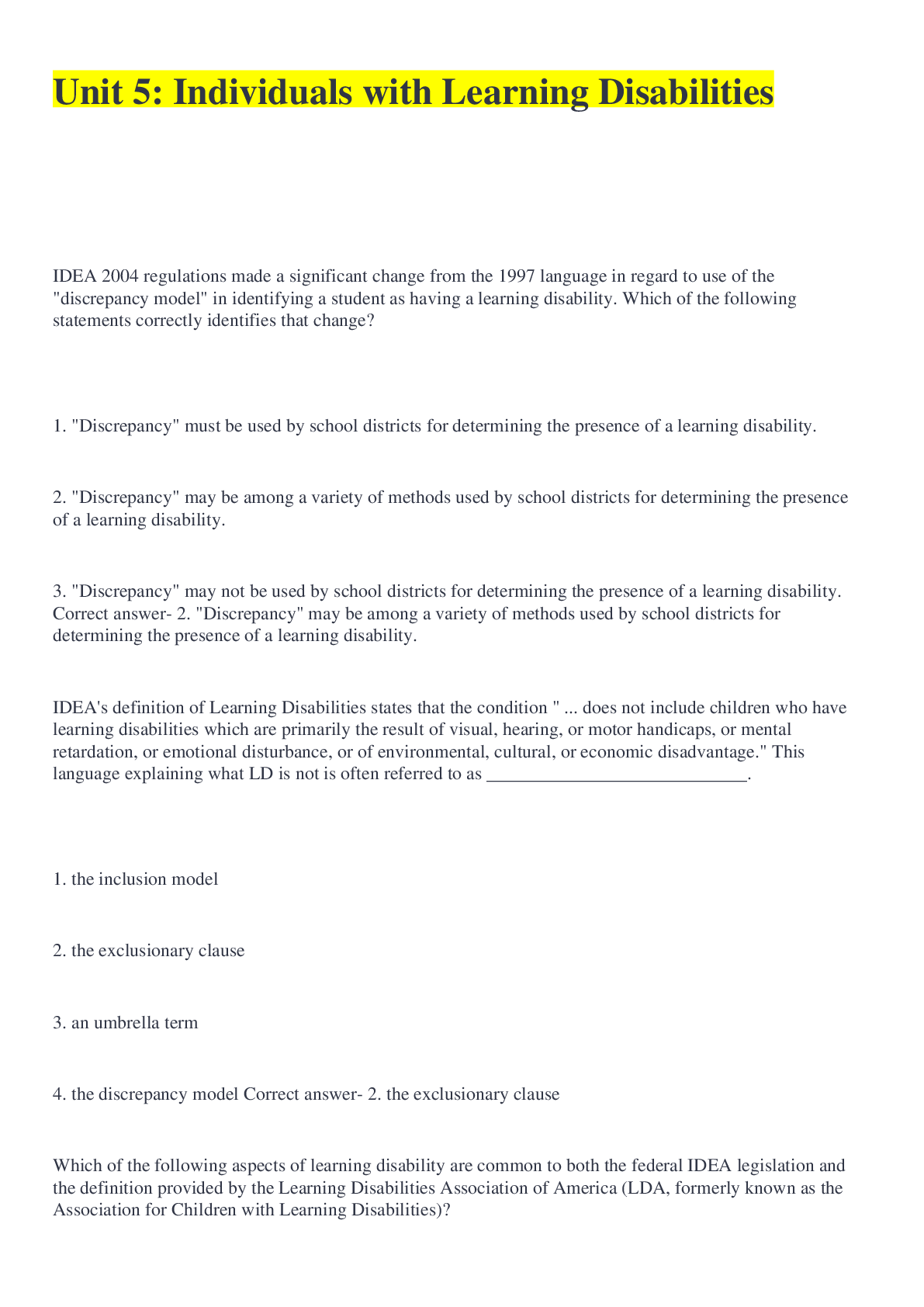ENTR 313: GUIDELINES FOR PREPARING A PITCH DECK PRESENTATION
Document Content and Description Below
Historically the business plan has been the most popular tool for entrepreneurs. There’s no right or wrong way to write a business plan. Business plan templates can be adapted to different life-cycl ... e stages of a business and different financing requirements that you may have both before and after you launch your business. What’s important is that your plan meets your particular needs. Most business plans fall into one of two common categories: traditional or lean startup (ie. the one page BMC which summarizes the nine most important points of the key elements of your plan and as practiced in class). Detailed business plans are a requirement for applying for funding from traditional sources like banks and the Kuwait National Fund. However, in the past decade, the business pitch deck is steadily growing in popularity as a tool to help entrepreneurs raise start- up capital or find other types of resources. A pitch deck is a good way to describe your business to a potential investor without the need to prepare a lengthy document. It can also be used for meetings with potential partners, advisors, mentors and employees. In fact any stakeholder that has a vested interest in your business could be an audience for your pitch. The slides are usually visually appealing relying more on pictures/photos, charts, graphs, mini videos and writing is usually kept to a minimum. Pitch decks allow the entrepreneur(s) to do more talking therefore giving him/her the chance to let their knowledge, research and passion shine through. There are no strict rules for the pitch deck length and slide. Slides can be anywhere between 5-30 depending on the needs of the audience and the allotted time frame. Regardless of the slide count or style, all pitch decks need to answer the following fundamental questions: • What is the problem or need? • How will you solve the problem or meet the need in a unique way? • Who is ‘the customer’ and are there enough of them to build a viable business? • What is the size of the market right now and in the future? • How will you reach, acquire and keep the customers? • Whom will you compete with and how are you different? • What is the revenue/expense model? • What capabilities do you and your team have to execute this business in a successful way? • What is your call to action ( ie. Why are you pitching-what do you want)? A typical meeting with a potential investor will be 30 minutes to one hour. You should not use all of this time to present, as it’s important to leave adequate time for discussion and questions. For the purpose of our class, we are assuming that you and your team are pitching in an entrepreneurship competition, in front of an audience of potential investors, who have pledged to financially back and mentor the winner. The rules of the competition require that you prepare you a 12-15 slide, business pitch deck using the following headings. PITCH DECK FRAMEWORK 1. Cover Slide: this should include the name of your company, logo, motto/tagline, names and contact information. Remember that this slide will be up on the screen for quite sometime, as the audience waits for you to start the presentation. First impressions count- pay attention to slide design. 2. Company Description and Purpose: This provides a quick overview of your company. Why do you exist/what do you do? Ex: “ Go Global sells computer-based simulations to university professors in order to help teach core topics related to international business and strategy” 3. The Problem/Need: Describe the problem your company is solving ( how did you prove this problem actually exists?) or how you are addressing a customer need. You should also mention how this problem is currently being addressed by other competition and point out any gaps/inefficiencies that exist. You need to prove to your audience that the problem is a big (important) one. 4. The Solution: The solution is really your value proposition. That is, if you solve the customer’s problem or fulfil their need in a unique way, then you are already creating value. Here you may also offer a live demonstration or show a prototype or a picture of it or even run the audience through how easy it is to use something-like an app. 5. Why Now?: This relates to the window of opportunity that we have discussed in class. You need to convince your audience that the time is now for your new product/service. This means pointing out trends or changes in the macro-environment/industry that proves your business is timely. You can also quote statistics. 6. Market Opportunity: Your solution is only powerful, if there is a market of customers who are willing to part with their hard earned cash in order to by your product/service. Who are your target customers? Create a detailed demographic profile (persona). How do you know that the customer would actually spend their hard earned cash on what you have to offer? What is the total estimated market size? What portion of the total market are you realistically aiming for? What are you basing these assumptions on? How have you validated your assumptions? Knowing the total available market (TAM) and the portion you think you can realistically capture is important for investors because, it shows that you have thought out which portion of the market you would like to initially concentrate on capturing and it also shows that there is growth potential for later on, should the business be successful. 7. Getting Customers: After depicting the market size and your typical customer/target market, you need to articulate how you will reach those customers, what they are willing to pay and how you intend to keep them coming back for repeat purchases. There's no single way to approach a marketing strategy. Your strategy should evolve and change to fit your unique needs. Here you need to describe your initial market entry strategy and how you'll attract customers. You'll also describe how a sale will actually happen. What distribution channels will you use to get the product out to the customer? What pricing strategy will you use? What promotional strategies will you use and why? 8. Competitor Analysis & Differentiation: Showing that you have done your homework on the industry and especially your competition is essential. Who are your direct and indirect competitors? A competitor analysis will clearly show how your business differentiates itself from others and the unique way in which it does so. A strong analysis will show the audience your competitive advantage and what will sustain you in the near future. You may pinpoint a handful of competitors that you would like to benchmark against and do an analysis/comparison based on certain variables/features eg. location, pricing, customer service, offering, capacity etc. You may also compare their strengths and weaknesses. As a result of this analysis, how do you position yourself against competitors? Which of Porter’s strategies (cost leadership, differentiation etc.) have you chosen? Remember that no matter what you do, there will always be competition! 9. Traction: This slide describes all the work that you have done till now to build your business/prepare to launch. Ex’s : Completion of customer research Launched a crowd funding campaign Product testing Secured a loan from the bank Signed a rental agreement for office space Completed government paperwork You may also present the future key milestones you hope to achieve as a company in the next 12 months after launching? You can use timelines/tables to show this. For ex. If you are launching an app, provide information about the design phase, product prototype phase, testing, product launch, version release. 10. Financials: This slide needs to demonstrate that you have a clear understanding of potential profit and loss. What is your start-up capital needs? What is your own financial contribution to this business and your sources (debt vs. equity financing). What is your revenue model? You need to highlight the key drivers of revenue and different types of expenses including your main fixed and variable costs. You can show and explain different revenue/profit scenarios based on assumptions that you are making. Try to be as realistic as possible, support your financials with references to show that you have actually done your research. 11. Team: Showing you have a strong team with the right skillset is more important than you might think. Remember the best of opportunities/plans mean nothing if the right people do not execute them. Explain how your company will be structured (what form of ownership will you use and why?) Who will run it? You may use an organizational chart. Explain how each person's unique experience will contribute to the success of your business. If you have a board of advisors, mention them as well. 12. Call to Action: This is the fundamental reason why you are presenting. The audience has been listening to you for at least the last 10-15 minutes- What do you want???? What you ask for depends on your audience. For example, if you are pitching to an investor, you are most likely asking for money, so you would also need to explain how you are going to use that money, the timeframe and pay back scheme. If you are presenting in class, you may be seeking the feedback of your peers and professor about your idea in order to refine it further. Get creative: Please feel free to add any other information that you would like to present as long as you don’t go over 15 slides and do not go over the 15 minute time limit. You will be graded on your ability to present within the given time limit, slide creativity, error free slides, depth of content delivered to audience [Show More]
Last updated: 3 years ago
Preview 1 out of 2 pages

Buy this document to get the full access instantly
Instant Download Access after purchase
Buy NowInstant download
We Accept:

Reviews( 0 )
$10.00
Can't find what you want? Try our AI powered Search
Document information
Connected school, study & course
About the document
Uploaded On
Aug 15, 2022
Number of pages
2
Written in
All
Additional information
This document has been written for:
Uploaded
Aug 15, 2022
Downloads
0
Views
150

.png)
















